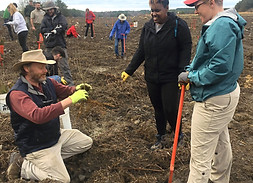OUR APPROACH
GFW uses a modified version of the Appalachian Regional Reforestation Initiative’s (ARRI) Forestry Reclamation Approach (FRA) to address mines that were reclaimed using pre-FRA methods (i.e. heavy soil compaction). The modified FRA calls for removing or controlling exotic, invasive vegetation, followed by cross-ripping the soil at least 3 feet deep to loosen compacted ground. Then, a mix of high-value, native trees and shrubs are properly planted by volunteers and/or professional tree planters. By following these steps, GFW is converting compromised lands back into healthy and productive native forests that will provide sustainable economic development and opportunities for entrepreneurship. Below are more details about each step of the process.

STEP 1: SECURE PLANTING SITE
GFW seeks bond-released surface mine sites where pre-FRA reclamation practices were used and successful reforestation is unlikely to occur in a reasonable time frame. We work with public and private landowners who are passionate and enthusiastic about reforestation.

STEP 2: SITE PREP
When necessary, local contractors are hired to remove or control exotic, invasive vegetation. Local equipment operators are hired to mitigate soil compaction by deep-ripping the ground with a 3-4 foot long ripping shank pulled by a large bulldozer or excavator.

STEP 3: TREE SELECTION
A mix of native, early successional tree and shrub species and valuable hardwoods are selected for wildlife and soil stability and a commercially valuable future crop, respectively. The species planted depends on the site’s location and the landowner’s desires. Bareroot seedlings are purchased from state or local commercial nurseries. Occasionally mature, containerized plants are used to provide immediate wildlife benefits.

STEP 4: TREE PLANTING
Seedlings are planted on an 8’x8’ spacing to initially provide approximately 680 trees/acre. Seedlings are planted at a high density so that after natural seedling mortality an appropriate stocking density remains. This density also allows the canopy to close quickly, which helps prevent invasive species from becoming reestablished. Volunteer groups or professional tree planters perform tree plantings.

STEP 5: MONITORING
Post-planting site visits are conducted by GFW employees to assess tree survival and growth. Follow-up maintenance and plantings are performed when necessary.